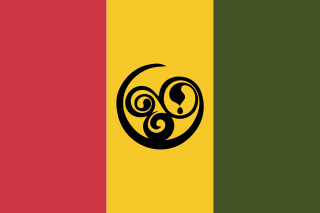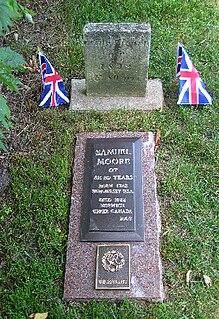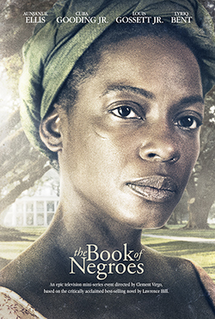
Sampson Salter Blowers was a noted North American lawyer, Loyalist and jurist from Nova Scotia who, along with Chief Justice Thomas Andrew Lumisden Strange, waged "judicial war" in his efforts to free Black Nova Scotian slaves from their owners, leading to the decline of slavery in Nova Scotia.

Loyalists were American colonists who remained loyal to the British Crown during the American Revolutionary War, often referred to as Tories, Royalists or King's Men at the time. They were opposed by the Patriots, who supported the revolution, and called them "persons inimical to the liberties of America."

Titus Cornelius, also known as Titus, Tye, and famously as Colonel Tye, was a slave of African descent in the Province of New Jersey who fought as a Black Loyalist during the American Revolutionary War; he was known for his leadership and fighting skills. He is most known for escaping slavery after being denied freedom from his master and finding refuge fighting for the British in the American Revolutionary War. He fought with a volunteer corps of escaped Virginia Colony slaves in the Ethiopian Regiment and he led the "Black Brigade" associators. Tye died from tetanus from a musket wound in the wrist following a short siege in September 1780 against Captain Joshua Huddy.Tye was one of the most feared and effective guerrilla leaders opposing the American patriot forces in central New Jersey.

Black Loyalists were people of African descent who sided with the Loyalists during the American Revolutionary War. In particular, the term refers to men who escaped enslavement by Patriot masters and served on the Loyalist side because of the Crown's guarantee of freedom.

The 84th Regiment of Foot was a British regiment in the American Revolutionary War that was raised to defend present day Ontario, Quebec and Atlantic Canada from the constant land and sea attacks by American Revolutionaries. The 84th Regiment was also involved in offensive action in the Thirteen Colonies; including North Carolina, South Carolina, Georgia, Virginia and what is now Maine, as well as raids upon Lake Champlain and the Mohawk Valley. The regiment consisted of 2,000 men in twenty companies. The 84th Regiment was raised from Scottish soldiers who had served in the Seven Years' War and stayed in North America. As a result, the 84th Regiment had one of the oldest and most experienced officer corps of any regiment in North America. The Scottish Highland regiments were a key element of the British Army in the American Revolution. The 84th Regiment was clothed, armed and accoutred the same as the Black Watch, with Lieutenant Colonel Allan Maclean commanding the first battalion and Major General John Small of Strathardle commanding the second. The two Battalions operated independently of each other and saw little action together.

The Old Burying Ground is a historic cemetery in Halifax, Nova Scotia, Canada. It is located at the intersection of Barrington Street and Spring Garden Road in Downtown Halifax.
Thomas Peters, born Thomas Potters, was a veteran of the Black Pioneers, fighting for the British in the American Revolutionary War. A Black Loyalist, he was resettled in Nova Scotia, where he became a politician and one of the "Founding Fathers" of the nation of Sierra Leone in West Africa. Peters was among a group of influential Black Canadians who pressed the Crown to fulfill its commitment for land grants in Nova Scotia. Later they recruited African-American settlers in Nova Scotia for the colonisation of Sierra Leone in the late eighteenth century.

Black Nova Scotians are Black Canadians whose ancestors primarily date back to the Colonial United States as slaves or freemen, later arriving in Nova Scotia, Canada, during the 18th and early 19th centuries. As of the 2016 Census of Canada, 21,915 Black people live in Nova Scotia, most in Halifax. Since the 1950s, numerous Black Nova Scotians have migrated to Toronto for its larger range of opportunities. Before the immigration reforms of 1967, Black Nova Scotians formed 37% of the total Black Canadian population.

John Marrant was one of the first African-American preachers and missionaries in North America. Born free in New York City, he moved as a child with his family to Charleston, South Carolina. His father died when he was young, and he and his mother also lived in Florida and Georgia. After escaping to the Cherokee, with whom he lived for two years, he allied with the British during the American Revolutionary War and resettled afterward in London. There he became involved with the Countess of Huntingdon's Connexion and ordained as a preacher.

Enoch Moore, son of Samuel Moore U.E. and Rachel Stone, married Elizabeth Smith, daughter of James Smith and Hannah Hawksworth, on March 30, 1803 in Old Holy Trinity Church, Lower Middleton, Annapolis County, Nova Scotia. Elizabeth was born on April 18, 1784 in Wilmot Township, NS, died on March 3, 1871 and was buried in New Milford Cemetery, Winnebago County, Illinois. Enoch was a direct descendant of one of New Jersey's early colonial officials, Samuel Moore.

David George was an African-American Baptist preacher and a Black Loyalist from the American South who escaped to British lines in Savannah, Georgia; later he accepted transport to Nova Scotia and land there. He eventually resettled in Freetown, Sierra Leone. With other slaves, George founded the Silver Bluff Baptist Church in South Carolina in 1775, the first black congregation in the present-day United States. He was later affiliated with the First African Baptist Church of Savannah, Georgia. After migration, he founded Baptist congregations in Nova Scotia and Freetown, Sierra Leone. George wrote an account of his life that is one of the most important early slave narratives.

The Book of Negroes is a document created by Brigadier General Samuel Birch, under the direction of Sir Guy Carleton, that records names and descriptions of 3,000 Black Loyalists, enslaved Africans who escaped to the British lines during the American Revolution and were evacuated to points in Nova Scotia as free people of colour.

In the American Revolution, gaining freedom was the strongest motive for Black enslaved people who joined the Patriot or British armies. It is estimated that 20,000 African Americans joined the British cause, which promised freedom to enslaved people, as Black Loyalists. Around 9,000 African Americans became Black Patriots.
John Kizell became known as a leader in Sierra Leone as it was being developed as a new British colony in the early nineteenth century. Believed born on Sherbro Island, he was captured and enslaved as a child, and shipped to Charleston, South Carolina, where he was sold again. Years later, after the American Revolutionary War, during which he gained freedom with the British and was evacuated to Nova Scotia, he eventually returned to West Africa. In 1792 he was among 50 native-born Africans among the 1200 mostly African-American Black Loyalists who were resettled in Freetown.

James De Lancey was a colonial American who led one of the best known and most feared of the loyalist units, De Lancey's Brigade, during the American Revolution. He was known as the "Commander of the Cowboys" by the loyalists and by the Patriots he was known as the "Outlaw of the Bronx". He later became a political figure in Nova Scotia. He represented Annapolis Township in the Nova Scotia House of Assembly from 1786 to 1794. He has become a controversial figure for unsuccessfully trying to use the courts to retrieve a slave he brought to Nova Scotia.

Samuel Moore (1742–1822) is notable as a leader in the early establishment of the Religious Society of Friends (Quakers) in Maritime Canada, and as the progenitor of a number of civic, religious and political leaders in both Canada and the United States.

Colonists who supported the British cause in the American Revolution were Loyalists, often called Tories, or, occasionally, Royalists or King's Men. George Washington's winning side in the war called themselves "Patriots", and in this article Americans on the revolutionary side are called Patriots. For a detailed analysis of the psychology and social origins of the Loyalists, see Loyalist.

The Book of Negroes is a 2015 television miniseries based on the 2007 novel of the same name by Canadian writer Lawrence Hill. The book was inspired by the British freeing and evacuation of former slaves, known as Black Loyalists, who had left rebel masters during the American Revolutionary War. The British transported some 3,000 Black Loyalists to Nova Scotia for resettlement, documenting their names in what was called the Book of Negroes.

The Province of Nova Scotia was heavily involved in the American Revolutionary War (1776–1783). At that time, Nova Scotia also included present-day New Brunswick until that colony was created in 1784. The Revolution had a significant impact on shaping Nova Scotia, "almost the 14th American Colony". At the beginning, there was ambivalence in Nova Scotia over whether the colony should join the Americans in the war against Britain. Largely as a result of American privateer raids on Nova Scotia villages, as the war continued, the population of Nova Scotia solidified their support for the British. Nova Scotians were also influenced to remain loyal to Britain by the presence of British military units, judicial prosecution by the Nova Scotia Governors and the efforts of Reverend Henry Alline.

Deborah Squash was a slave on George Washington's Mount Vernon plantation before she escaped in 1781. She went to New Amsterdam, which was the headquarters for the British during the American Revolution. At the end of the war, she was one of the 3,000 blacks in the Book of Negroes that sailed on a British ship for Nova Scotia.

















